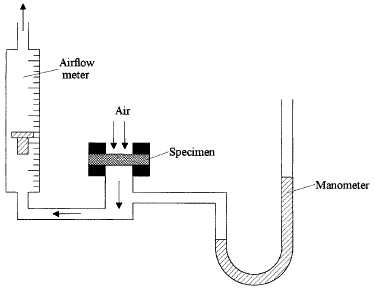This test method covers the measurement of the air permeability of textile fabrics.
This test method applies to most fabrics including woven fabrics, nonwoven fabrics, air bag fabrics, blankets, napped fabrics, knitted fabrics, layered fabrics, and pile fabrics. The fabrics may be untreated, heavily sized, coated, resin-treated, or otherwise treated.
The values stated in SI units are to be regarded as the standard. The values stated in inch-pound units may be approximate.
This standard does not purport to address all of the safety concerns, if any, associated with its use. It is the responsibility of the user of this standard to establish appropriate safety and health practices and determine the applicability of regulatory limitations prior to use.
This test method is considered satisfactory for acceptance testing of commercial shipments since current estimates of between-laboratory precision are acceptable, and this test method is used extensively in the trade for acceptance testing.In case of a dispute arising from differences in reported test results when using this test method for acceptance testing of commercial shipments, the purchaser and the supplier should conduct comparative tests to determine if there is a statistical bias between their laboratories. Competent statistical assistance is recommended for the investigation of bias. As a minimum, the two parties should take a group of test specimens that are as homogeneous as possible and that are from a lot of material of the type in question. Test specimens then should be randomly assigned in equal numbers to each laboratory for testing. The average results from the two laboratories should be compared using the appropriate statistical analysis and an acceptable probability level chosen by the two parties before testing is begun. If a bias is found, either its cause must be found and corrected, or the purchaser and the supplier must agree to interpret future test results with consideration of the known bias.

Air permeability is an important factor in the performance of such textile materials as gas filters, fabrics for air bags, clothing, mosquito netting, parachutes, sails, tentage, and vacuum cleaners. In filtration, for example, efficiency is directly related to air permeability. Air permeability also can be used to provide an indication of the breathability of weather-resistant and rainproof fabrics, or of coated fabrics in general, and to detect changes during the manufacturing process.
Performance specifications, both industrial and military, have been prepared on the basis of air permeability and are used in the purchase of fabrics where permeability is of interest.
Construction factors and finishing techniques can have an appreciable effect upon air permeability by causing a change in the length of airflow paths through a fabric. Hot calendaring can be used to flatten fabric components, thus reducing air permeability. Fabrics with different surface textures on either side can have a different air permeability depending upon the direction of air flow.For woven fabric, yarn twist also is important. As twist increases, the circularity and density of the yarn increases, thusreducing the yarn diameter and the cover factor and increasing the air permeability. Yarn crimp and weave influence the shape and area of the interstices between yarns and may permit yarns to extend easily. Such yarn extension would open up the fabric, increase the free area, and increase the air permeability.Increasing yarn twist also may allow the more circular, high-density yarns to be packed closely together in a tightly woven structure with reduced air permeability. For example, a worsted gabardine fabric may have lower air permeability than a woolen hopsacking fabric.
